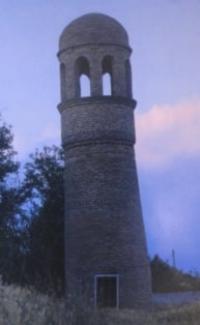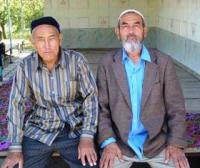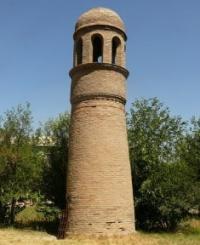You are here
Minaret of Khyzyr Paygambar.



Tours of historical monuments of Sairam.
“To the west of the Mazar Ishan (Mirali Baba) stands the mausoleum of Bibigiyas-ana. This is the beloved mother of Hazret Khizra ..."
The book "History of Sairam".
Ancient monuments in the village of Sairam.
The minaret of Khyzyr is located 15 kilometers from the city of Shymkent, Turkestan region. Dates IX - XII centuries The fortress Sairam is one of the oldest settlements in the territory of South Kazakhstan. The only surviving minaret in Sairam is named after the prophet Khyzyr Paygambar, who is mentioned in the Qur'an as an unnamed companion of Musa (Moses).
The height of the minaret is 10.5 m. According to popular belief, every Friday evening Hazret Khizir visits the mazars of his parents Bibigiyas-ana and Salyk Khoja to bow to their ashes. In the era of the early Middle Ages (IX - XII centuries), the city of Ispidzhab was located on the site of Sairam - the center of the eponymous district that was part of Maverannahr.
According to travelers, in 1866 the upper part of this minaret began to collapse. As a result of the earthquake of 1948, its upper part was completely destroyed. The height of the part that has been preserved so far is more than 6 meters, they believe that it is two thirds of the total height.
According to the “Risopai Sarem-ysfizhob”, the minaret and mosque of St. KHyzr were built in the Xth century, during the reign of Sultan Maisur, when Abdurahman Kazi was the judge, for 30 years. Inside the minaret there is a spiral staircase along which the muezzin climbed five times a day.
\The mosque, built at the same time as the minaret, was not preserved, but a three-kilometer underground passage leading to the chillahan was preserved. The book “History of Sairam” says: “To the west of the Mazar Ishan (Mirali Baba) is the mausoleum of Bibigiyas-ana.
This is the beloved mother of Hazret Khyzr..." Mazars, mounted on the grave, collapsed in time immemorial. But in 1998, the residents of Sairam erected a new small mausoleum in Bibigiyas-ane. The monument consists of two rooms.
In its western part there is a tomb, and a canopy is built at the exit. It serves as a place for prayers and worship. To the east of Sairam, on the road leading to Karamurt aul, rises the mausoleum of Salyk Khoja. Mazar is built in the style of medieval buildings, two-level, quadrangular in shape with a dome. Its dimensions: area - 6.7 x 5 meters, height - 7 meters is made of burnt brick 27 x 27 x 5 cm, clay was also used in construction.
Over time, the paint on the dome has disappeared. Dating back to the 17th century, the mausoleum was destroyed several times, restored and lost its former appearance. According to the old people and the testimony of the book “History of Isfijab-Sairam”, Salyk Khoja was the father of Hazret Khizir.
He was a wise scientist, an enlightened man, a prominent figure of his time and passionately loved his native people. According to popular belief, every Friday evening twilight, Hazret Khizir visits the mazars of his parents Bibigiyas-ana and Salyk Khoja to bow to their ashes.
The Middle Ages, when Islam reached its peak, revealed a huge number of illustrious rulers and leaders of the people, spiritual leaders and enlighteners. One of them was the ruler of Sairam Sultan Mansur (IX - X centuries).
As written in the historical book "Risala", along with education and justice, contemporaries honored him for his good attitude to the people and the care that he showed to people. For example, he paid special attention to the expansion of gardens and arable land, landscaping.
In “Risal” there are such lines: “Arystan Khan died of cholera, and Sultan Mansur took his place as ruler of Sairam. He built many mosques, minarets and underground roads. Over the course of thirty years, he did a lot of useful work.
"When the raids of the invaders against the people in abundance became more frequent, the Sultan Mansur sent a message to the Islamic sheikh Raisid Din that the enemy was close. Having gathered a common army, they gave the enemy a worthy rebuff.
The Mansur sultan distinguished himself not only courageous, he was a very enlightened and cultured man, and he was arrested in Samarkand by slander of envious men. Innocently imprisoned in Zindan, Sheikh Mansur spent days in the service of Allah.
He was vividly interested in the fellow countrymen who came to visit him: “Did you get a lot of snow in the mountains? Was the crop good? Do the children attend school? How are people doing? ..” Finding out that the ruler of Sairam was innocent, Ismail Samani released him from prison and received it with great honor.
After returning to his homeland, Sultan Mansur refused to rule and took up farming. He thought about the people, about how to help widows and orphans. Four hundred camp yurts were set up in the steppe, new ditches were dug, they prepared mercy for new crops and gardens, and when the crop was ripe, they divided it among those in need.
In one of the manuscripts stored in the Sairam Museum, it is recorded that, by his origin, Sultan Mansur belonged to the maternal line of the prophet Muhammad.
Authority:
"Monuments of Central Asia." Author M. Khashimov. Saga Publishing House, 2001. Samarkand. “Masterpieces of Central Asia”, Tashkent, Sanat Publishing House, 2004. www.farsah.kz.







